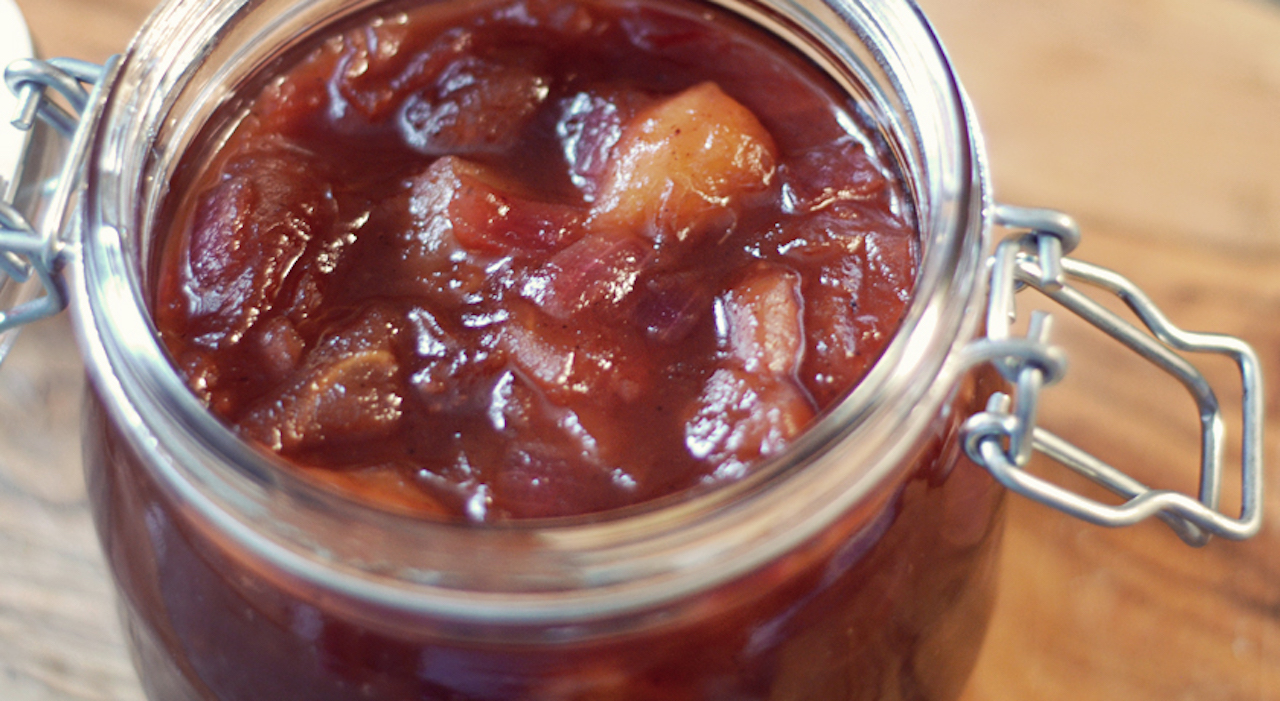
Who couldn’t use a bit more piquant in their life? I could, and chutneys fit the bill perfectly. Chutneys originated in India—thus they use a traditional Indian root spice, ginger. While the thought of putting up some beautiful jars of preserves might appeal to you straight off, you might think that it’s as far as a chutney can take you. Heavens no!
Once made, you will find all kinds of uses for them. I like a chutney spread over cream cheese on bagels or crackers. Spread on a sandwich for a great low-calorie, low-cholesterol alternative to mayo. My favorite way to use a chutney is to spread it over a meat that is designated for the outdoor grill. Turkey breast, chicken, pork or beef, it doesn’t really matter. A person can take only so much BBQ sauce.
Once I get back into cooking long, slow, roasts in the indoor kitchen, I use them even more; Cook a pork roast on a bed of sauerkraut. Spread the apple tomato chutney over the roast and cook, covered, for 40 minutes to the pound at 350 F. The pork should have an internal temperature of 160 degrees when you remove it from the oven. It’s delicious and moist and the sauerkraut melds with the flavor of the chutney most wonderfully.
Hints for making chutney:
Always use an enamel (make sure there are no pits) or a stainless steel pot when cooking your chutney. Actually this is a good rule for any preserves that have high acid in the recipe.
Chutneys, because of their fruit content, and the honey, can burn quite easily, especially as they reach the end of their cooking time and they are very thick. so I use a heat diffuser for this—it is a simple round of metal with a bunch of air holes in it that helps “diffuse” the heat more evenly. You can find them at a department store in the utensil section.
When canning or preserving – the quantities produced vary because of thickness of your slices or chunks, how much of the liquid evaporates, how much volume it starts with, etc. So, fill your jars, leaving the required amount of headroom, then pour the rest into a glass and refrigerate. Use this amount first when cooking. Do not try to squeeze it in to the jars.
Use small jars. These recipes call for half-pints. The small jars make sense because you will use it up promptly. This is preferable to having a half-full jar in the back of the refrigerator shelf for weeks or even months.
In terms of ingredients: you can substitute sugar for honey, but I especially like the smooth richness of the honey. For general purposes if you are experimenting with recipes that call for sugar to start with, you can substitute half that amount when using honey.
Ginger root is indispensable to making chutneys. It is quite easy to find in any produce counter nowadays. A little goes a long way – just buy one root and keep it refrigerated until you use it.
Peach or apricot chutney
Makes 4 jars, half-pints
- 1/2 cup honey
- 1/2 cup cider vinegar
- 1/2 cup chopped sweet onions
- 1 tsp. allspice
- 1 Tbsp. grated fresh ginger
- 1/4 cup raisins
- 5 cups fresh peaches or apricots, peeled, pitted, and chopped
In pot, combine the honey, vinegar, onions, allspice, raisins, and ginger and simmer for 10 minutes. Add the chopped fruit and cook at a simmer for 30 minutes more or until thick. Stir regularly.
Pour into scalded jars, leaving 1/4 inch headroom. Seal and process for 5 minutes in a boiling water bath.
Apple tomato chutney
Makes 4 half-pints
- 1-1/2 cups chopped tomatoes
- 1-1/2 cups peeled and chopped apples
- 1 cup raisins
- 2/3 cup chopped sweet onions
- 1/3 cup cider vinegar
- 1/3 cup water
- 3 Tbsps. honey
- 2 tsps. mustard seeds
- 2 thin slices of fresh ginger root
- 1 whole hot pepper
- 1 lemon, cut in half
- 1 clove fresh garlic
In a pot, combine tomatoes, apples, raisins, onions, vinegar, water and honey. In a cheesecloth bag, combine the mustard seeds, ginger root, hot pepper, lemon halves and garlic. Tie the bag shut and add to your chutney mixture. Bring to a boil, then reduce to a simmer and cook for 20 minutes.
Remove and discard the cheesecloth bag. Pour remaining mixture into scalded jars, leaving 1/4 inch headspace. Seal and process for 5 minutes in a boiling water bath.

